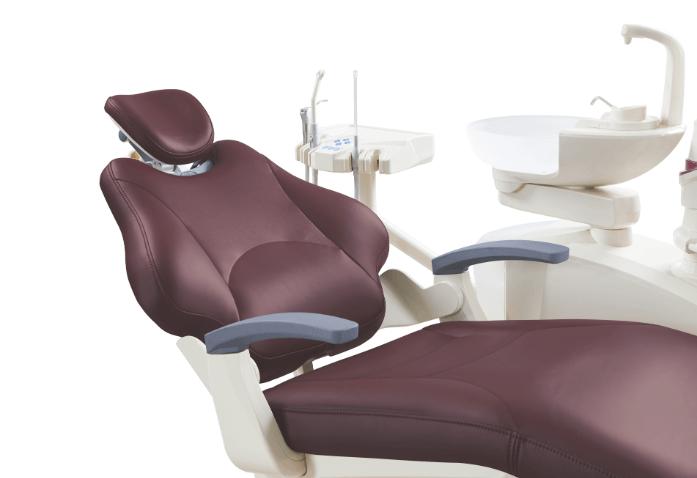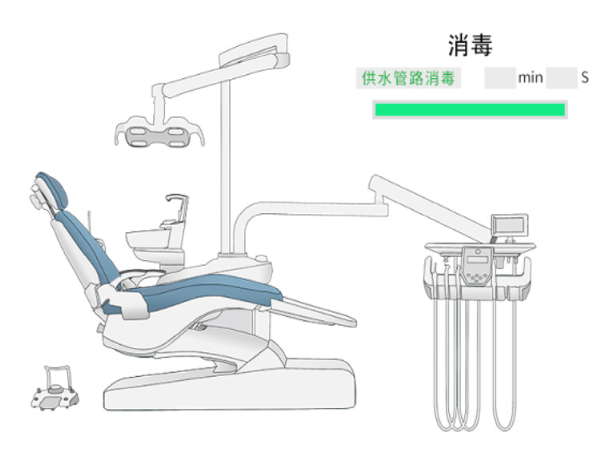أهمية تعقيم صواني كراسي الأسنان
تميزت بداية ممارسة طب الأسنان الحديثة بتطورات كبيرة في راحة المريض وسلامته، وكان كرسي الأسنان المتكئ تطورًا محوريًا. ومع ذلك، وراء الجوانب المرئية لرعاية الأسنان، مثل التصميم المريح لكرسي الأسنان المتكئ أو الراحة التي يوفرها وضع الاستلقاء في كرسي الأسنان، تكمن عملية التعقيم الحاسمة، وإن كانت أقل وضوحًا.
إن تعقيم صواني الأسنان، وهو عنصر لا غنى عنه في إجراءات طب الأسنان، له أهمية بالغة في منع انتقال الأمراض المعدية وضمان أعلى معايير النظافة. ورغم أن هذه الصواني قد لا تتمتع بالجاذبية الفريدة التي تتمتع بها الكراسي المصممة على شكل أسنان أو الآليات المتطورة التي تتمتع بها الكراسي الطبية المعروضة للبيع، فإنها تشكل أبطالاً مجهولين في مجال سلامة صحة الأسنان.
تتعمق هذه المقالة في تاريخ ومخاطر وأفضل الممارسات المحيطة بتعقيم صواني الأسنان، وهي عملية بالغة الأهمية مثل اختراع أول كرسي أسنان متكئ. وسوف نستكشف الرحلة الدقيقة من مرحلة ما قبل التنظيف إلى التخزين النهائي لهذه الأدوات الحيوية، مع التأكيد على أهمية التعقيم في حماية كل من الممارسين والمرضى.
إن تعقيم صواني الأسنان، وهو عنصر لا غنى عنه في إجراءات طب الأسنان، له أهمية بالغة في منع انتقال الأمراض المعدية وضمان أعلى معايير النظافة. ورغم أن هذه الصواني قد لا تتمتع بالجاذبية الفريدة التي تتمتع بها الكراسي المصممة على شكل أسنان أو الآليات المتطورة التي تتمتع بها الكراسي الطبية المعروضة للبيع، فإنها تشكل أبطالاً مجهولين في مجال سلامة صحة الأسنان.
تتعمق هذه المقالة في تاريخ ومخاطر وأفضل الممارسات المحيطة بتعقيم صواني الأسنان، وهي عملية بالغة الأهمية مثل اختراع أول كرسي أسنان متكئ. وسوف نستكشف الرحلة الدقيقة من مرحلة ما قبل التنظيف إلى التخزين النهائي لهذه الأدوات الحيوية، مع التأكيد على أهمية التعقيم في حماية كل من الممارسين والمرضى.
مخاطر عدم تعقيم قوالب الأسنان
إن عدم تعقيم صواني كراسي الأسنان بشكل صحيح يمكن أن يؤدي إلى عواقب وخيمة لكل من أطباء الأسنان والمرضى. وتشمل مخاطر عدم تعقيم صواني الأسنان انتشار الأمراض المعدية والتلوث المتبادل والعواقب القانونية والأخلاقية.
●إن أحد أهم المخاطر المترتبة على عدم تعقيم صواني الأسنان هو انتشار الأمراض المعدية. حيث يمكن أن تخلق إجراءات طب الأسنان بيئة عالية الخطورة لانتقال مسببات الأمراض المنقولة بالدم مثل التهاب الكبد B والتهاب الكبد C وفيروس نقص المناعة البشرية.
إذا لم يتم تعقيم صواني الأسنان بشكل صحيح، فإنها قد تصبح ملوثة بهذه مسببات الأمراض، وإذا أعيد استخدامها دون تعقيم مناسب، فإنها قد تنقل هذه الأمراض إلى المرضى الآخرين.
●التلوث المتبادل هو خطر كبير آخر مرتبط بعدم تعقيم صواني الأسنان. عندما لا يتم تعقيم الصواني بشكل صحيح، فإنها يمكن أن تنقل البكتيريا ومسببات الأمراض الأخرى من فم مريض إلى آخر، مما يؤدي إلى انتشار العدوى.
يمكن أن يحدث هذا حتى لو تم استخدام الصينية في منطقة مختلفة من فم نفس المريض، مما يسلط الضوء على أهمية تعقيم جميع المعدات الطبية في طب الأسنان بشكل صحيح.
●بخلاف المخاطر الصحية المباشرة، فإن التبعات القانونية والأخلاقية المترتبة على إهمال تعقيم صواني الأسنان عميقة. فممارسات طب الأسنان ملزمة قانونًا بتوفير بيئة آمنة لمرضاها؛ وقد يؤدي انتهاك هذا الواجب إلى عواقب قانونية وخيمة، مثل دعاوى الإهمال الطبي. ومن الناحية الأخلاقية، يجب على أطباء الأسنان وضع سلامة المرضى في طليعة ممارساتهم من خلال الالتزام ببروتوكولات التعقيم الصارمة. وتعتمد سلامة رعاية المرضى على هذا الالتزام بالمعايير الصارمة للنظافة والسلامة.
عملية تعقيم قوالب الأسنان
يعد تعقيم صواني الأسنان خطوة بالغة الأهمية لضمان سلامة كل من أطباء الأسنان والمرضى أثناء إجراءات طب الأسنان. تتضمن عملية تعقيم صواني الأسنان عدة خطوات، بما في ذلك التنظيف المسبق للصواني، وتطهير الصواني، وتعقيم الصواني، وتخزين الصواني المعقمة بشكل صحيح.
●الخطوة الأولى في العملية هي التنظيف المسبق للصينية. يتضمن ذلك إزالة أي حطام أو مواد عضوية من سطح الصينية، مما يجعل تطهيرها وتعقيمها أسهل. يمكن إجراء التنظيف المسبق باستخدام محلول منظف أو عن طريق فرك الصينية يدويًا باستخدام فرشاة.
●الخطوة التالية هي تطهير الصينية. تتضمن عملية التطهير استخدام محلول مطهر لقتل أي كائنات دقيقة قد تكون موجودة على سطح الصينية. يجب وضع محلول المطهر وفقًا لإرشادات الشركة المصنعة وتركه على سطح الصينية لمدة زمنية موصى بها.
●بعد التطهير، يجب تعقيم الصينية لقتل أي كائنات دقيقة متبقية. يمكن أن تختلف طريقة التعقيم حسب نوع الصينية ومعدات عيادة الأسنان.
تشمل طرق التعقيم الشائعة التعقيم بالبخار والتعقيم الكيميائي والتعقيم بالحرارة الجافة. ومن الضروري اتباع تعليمات الشركة المصنعة لطريقة التعقيم المختارة لضمان التعقيم الفعال.
●أخيرًا، يعد تخزين الصواني المعقمة بشكل صحيح أمرًا ضروريًا لضمان بقائها معقمة حتى يتم استخدامها في إجراء طب الأسنان. يجب تخزين الصواني المعقمة في بيئة نظيفة وجافة، بعيدًا عن أي مصادر محتملة للتلوث. يجب أيضًا تنظيف منطقة التخزين وتطهيرها بانتظام للحفاظ على بيئة معقمة.
خاتمة
يعد تعقيم صواني الأسنان أمرًا ضروريًا للحفاظ على سلامة المرضى ومنع انتشار الأمراض المعدية. يقع على عاتق أطباء الأسنان مسؤولية التأكد من تعقيم جميع أدوات الأسنان، بما في ذلك الصواني، بشكل صحيح قبل الاستخدام.
باتباع أفضل الممارسات الموضحة في هذه المقالة، يمكن لممارسات طب الأسنان ضمان حصول مرضاهم على علاج أسنان آمن وفعال. يجب علينا إعطاء الأولوية لإجراءات التعقيم المناسبة في عيادات طب الأسنان لحماية صحة المرضى والحفاظ على معايير عالية لرعاية المرضى.
باتباع أفضل الممارسات الموضحة في هذه المقالة، يمكن لممارسات طب الأسنان ضمان حصول مرضاهم على علاج أسنان آمن وفعال. يجب علينا إعطاء الأولوية لإجراءات التعقيم المناسبة في عيادات طب الأسنان لحماية صحة المرضى والحفاظ على معايير عالية لرعاية المرضى.



اترك تعليقا